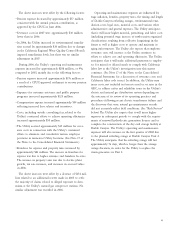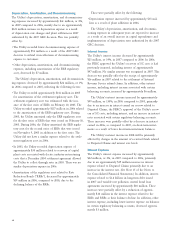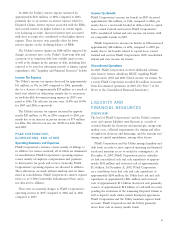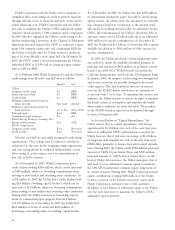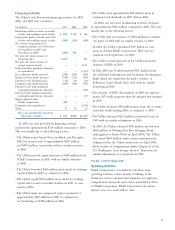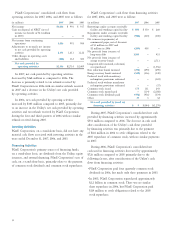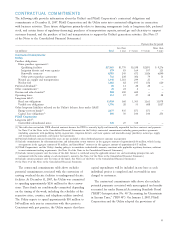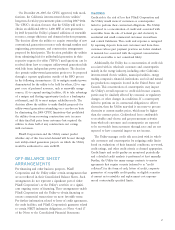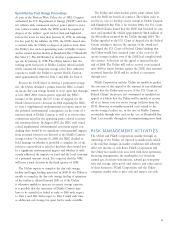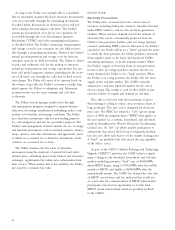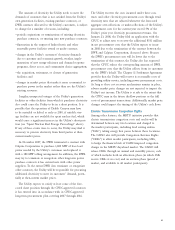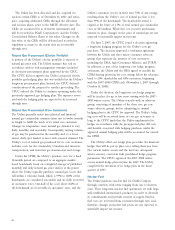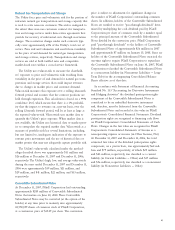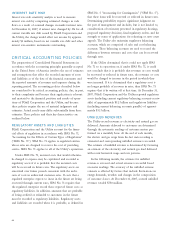PG&E 2007 Annual Report Download - page 56
Download and view the complete annual report
Please find page 56 of the 2007 PG&E annual report below. You can navigate through the pages in the report by either clicking on the pages listed below, or by using the keyword search tool below to find specific information within the annual report.54
FIN 48. (See “Adoption of New Accounting Pronounce-
ments” in Note 2 of the Notes to the Consolidated Financial
Statements for a discussion of the impact of adoption and
the unrecognized tax benefi ts balance as of December 31,
2007.) Due to the uncertainty surrounding tax audits,
PG&E Corporation and the Utility cannot make reliable
estimates of the amount and period of future payments to
major tax jurisdictions related to FIN 48 liabilities. Matters
relating to tax years that remain subject to examination
are discussed in Note 11 of the Notes to the Consolidated
Financial Statements.
CAPITAL EXPENDITURES
The Utility’s investment in plant and equipment totaled
$2.8 billion in 2007, $2.4 billion in 2006, and $1.9 billion in
2005. The Utility expects that capital expenditures will total
approximately $3.6 billion in 2008 and forecasts that capital
expenditures will average approximately $3.4 billion over
each of the next four years. The Utility’s weighted average
rate base in 2007 was $16.8 billion. Based on the estimated
capital expenditures for 2008 and 2009, the Utility projects
a weighted average rate base of approximately $18.4 billion
for 2008 and approximately $20.8 billion for 2009.
The Utility forecasts that it will make various capital
investments in its electric and gas transmission and dis-
tribution infrastructure to maintain and enhance system
reliability and customer service, to extend the life of or
replace existing infrastructure, to add new infrastructure to
meet already authorized growth, and to implement various
initiatives designed to achieve operating and cost effi ciencies.
The Utility also is exploring obtaining regulatory approval
for potential investments in electric transmission projects,
including the proposed 500 kV Central California Clean
Energy Transmission project and a proposed new high volt-
age transmission line to run between Northern California
and British Columbia, Canada. In addition, as discussed
below, the Utility has been incurring substantial capital
expenditures in connection with projects that have already
begun, including the construction or acquisition of new
generation facilities and the installation of an advanced
metering system.
PG&E Corporation also may make material investments
in two natural gas transmission pipeline projects through
2011: the proposed 230-mile Pacifi c Connector Gas Pipeline
that would begin at the proposed Jordan Cove liquefi ed
natural gas (“LNG”) terminal to be located in Coos Bay,
Oregon and connect with the Utility’s transmission system
near Malin, Oregon, and the proposed 680-mile Ruby
Pipeline that would begin in Wyoming and terminate at
the Malin, Oregon interconnect, near California’s northern
border. PG&E Corporation, through its subsidiary, PG&E
Strategic Capital, Inc., along with Fort Chicago Energy
Partners, L.P. and Northwest Pipeline Corporation, have
agreed to jointly pursue the development of the Pacifi c
Connector Gas Pipeline which is dependent upon the devel-
opment of the Jordan Cove LNG terminal by Fort Chicago
Energy Partners, L.P. In September 2007, applications with
the FERC were fi led to request authorization to construct
the proposed Pacifi c Connector Gas Pipeline and the Jordan
Cove LNG terminal. It is expected that the FERC will
issue a decision by the end of 2008. Assuming the required
permits, regulatory approvals, and long-term capacity com-
mitments for both the terminal and pipeline are timely
received and that other conditions are timely satisfi ed, it is
anticipated that the proposed LNG terminal and the proposed
Pacifi c Connector Gas Pipeline could begin commercial
operation in 2011. In December 2007, PG&E Corporation
entered into a letter of intent with El Paso Corporation to
acquire a 25.5 percent interest in El Paso Corporation’s pro-
posed Ruby Pipeline. PG&E Corporation’s acquisition of
an interest in the Ruby Pipeline project is subject to various
conditions, including the negotiation and execution of the
partnership documents. Subject to obtaining the required
regulatory and other approvals, including the approvals of
the boards of directors of PG&E Corporation and El Paso
Corporation, and after obtaining necessary customer com-
mitments, the Ruby Pipeline is anticipated to be in service
in the fi rst quarter of 2011. PG&E Corporation cannot pre-
dict whether the regulatory approvals and other conditions
for development of the Pacifi c Connector Gas Pipeline and
the Ruby Pipeline will be met.
SmartMeter™ Program
In July 2006, the CPUC approved the Utility’s application
to install an advanced metering infrastructure, known as
the SmartMeter™ program, for virtually all of the Utility’s
electric and gas customers. This infrastructure results in
substantial cost savings associated with billing customers for
energy usage, and enables the Utility to measure usage of elec-
tricity on a time-of-use basis and to charge demand-response
rates. The main goal of demand-response rates is to encour-
age customers to reduce energy consumption during peak
demand periods and to reduce peak period procurement
costs. Advanced meters can record usage in time intervals
and be read remotely. The Utility began installation of the
infrastructure in 2006 and expects to complete the installa-
tion throughout its service territory by the end of 2011.



